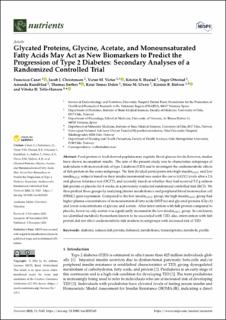| dc.contributor.author | Canet, Francisco | |
| dc.contributor.author | Christensen, Jacob J. | |
| dc.contributor.author | Victor, Victor M. | |
| dc.contributor.author | Hustad, Kristin Solheim | |
| dc.contributor.author | Ottestad, Inger | |
| dc.contributor.author | Rundblad, Amanda | |
| dc.contributor.author | Sæther, Thomas | |
| dc.contributor.author | Dalen, Knut Tomas | |
| dc.contributor.author | Ulven, Stine Marie | |
| dc.contributor.author | Holven, Kirsten Bjørklund | |
| dc.contributor.author | Telle-Hansen, Vibeke | |
| dc.date.accessioned | 2023-02-21T08:27:39Z | |
| dc.date.available | 2023-02-21T08:27:39Z | |
| dc.date.created | 2022-12-16T10:05:44Z | |
| dc.date.issued | 2022-12-05 | |
| dc.identifier.citation | Nutrients. 2022, 14 (23), 1-19. | en_US |
| dc.identifier.issn | 2072-6643 | |
| dc.identifier.uri | https://hdl.handle.net/11250/3052561 | |
| dc.description.abstract | Food protein or food-derived peptides may regulate blood glucose levels; however, studies have shown inconsistent results. The aim of the present study was to characterize subgroups of individuals with increased risk of type 2 diabetes (T2D) and to investigate the cardiometabolic effects of fish protein in the same subgroups. We first divided participants into high insuliniAUC and low insuliniAUC subjects based on their insulin incremental area under the curve (iAUC) levels after a 2 h oral glucose tolerance test (OGTT), and secondly based on whether they had received 5.2 g salmon fish protein or placebo for 8 weeks, in a previously conducted randomized controlled trial (RCT). We then profiled these groups by analyzing plasma metabolomics and peripheral blood mononuclear cell (PBMC) gene expression. Compared to the low insuliniAUC group, the high insuliniAUC group had higher plasma concentrations of monounsaturated fatty acids (MUFAs) and glycated proteins (GlycA) and lower concentrations of glycine and acetate. After intervention with fish protein compared to placebo, however, only acetate was significantly increased in the low insuliniAUC group. In conclusion, we identified metabolic biomarkers known to be associated with T2D; also, intervention with fish protein did not affect cardiometabolic risk markers in subgroups with increased risk of T2D. | en_US |
| dc.language.iso | eng | en_US |
| dc.publisher | MDPI | en_US |
| dc.relation.ispartofseries | Nutrients;Volume 14 / Issue 23 | |
| dc.rights | Navngivelse 4.0 Internasjonal | * |
| dc.rights.uri | http://creativecommons.org/licenses/by/4.0/deed.no | * |
| dc.title | Glycated proteins, glycine, acetate, and monounsaturated fatty acids may act as new biomarkers to predict the progression of type 2 diabetes: Secondary analyses of a randomized controlled trial | en_US |
| dc.type | Peer reviewed | en_US |
| dc.type | Journal article | en_US |
| dc.description.version | publishedVersion | en_US |
| dc.rights.holder | © 2022 by the authors | en_US |
| dc.source.articlenumber | 5165 | en_US |
| cristin.ispublished | true | |
| cristin.fulltext | original | |
| cristin.qualitycode | 1 | |
| dc.identifier.doi | https://doi.org/10.3390/nu14235165 | |
| dc.identifier.cristin | 2094180 | |
| dc.source.journal | Nutrients | en_US |
| dc.source.volume | 14 | en_US |
| dc.source.issue | 23 | en_US |
| dc.source.pagenumber | 1-19 | en_US |
| dc.relation.project | FHF – Fiskeri- og havbruksnæringens forskningsfinansiering: 901420 | en_US |
| dc.relation.project | Generalitat Valenciana: GRISOLIAP/2019/091 | en_US |
| dc.relation.project | Generalitat Valenciana: BEFPI/2021/011 | en_US |

